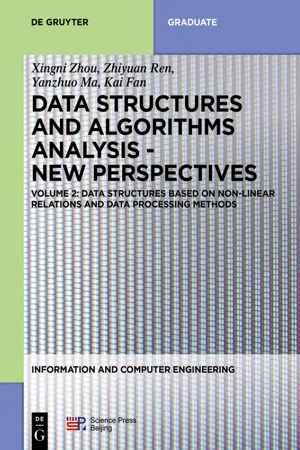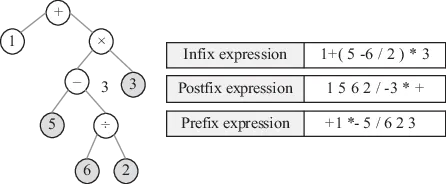
eBook - ePub
Data structures based on non-linear relations and data processing methods
This is a test
- 371 pages
- English
- ePUB (mobile friendly)
- Available on iOS & Android
eBook - ePub
Data structures based on non-linear relations and data processing methods
Book details
Book preview
Table of contents
Citations
About This Book
The systematic description starts with basic theory and applications of different kinds of data structures, including storage structures and models. It also explores on data processing methods such as sorting, index and search technologies. Due to its numerous exercises the book is a helpful reference for graduate students, lecturers.
Frequently asked questions
At the moment all of our mobile-responsive ePub books are available to download via the app. Most of our PDFs are also available to download and we're working on making the final remaining ones downloadable now. Learn more here.
Both plans give you full access to the library and all of Perlego’s features. The only differences are the price and subscription period: With the annual plan you’ll save around 30% compared to 12 months on the monthly plan.
We are an online textbook subscription service, where you can get access to an entire online library for less than the price of a single book per month. With over 1 million books across 1000+ topics, we’ve got you covered! Learn more here.
Look out for the read-aloud symbol on your next book to see if you can listen to it. The read-aloud tool reads text aloud for you, highlighting the text as it is being read. You can pause it, speed it up and slow it down. Learn more here.
Yes, you can access Data structures based on non-linear relations and data processing methods by Xingni Zhou, Zhiyuan Ren, Yanzhuo Ma, Kai Fan, Xiang Ji in PDF and/or ePUB format, as well as other popular books in Computer Science & Data Mining. We have over one million books available in our catalogue for you to explore.
Information
1 Nonlinear structure with layered logical relations between nodes – tree
Main Contents
- The definition of tree and basic terminologies
- The concept of binary tree and its storage structure
- The traversal of binary tree
- Huffman tree and its applications
- The concept, storage structure and basic operations of lists
Learning Aims
- Comprehend the transition from linear structure to nonlinear structure of the logical structure of data
- Comprehend linear structures that contain child structure
- Understand the functionality of linked storage structure in expressing nonlinear data structures
- Comprehend the concept, storage method and basic operations on trees
- Understand the concept, structural characteristics and storage/representation methods of lists
1.1 Tree in actual problems
1.1.1 Introductory example to tree 1 – tree-like structures in our daily life
If we enter a huge library, and want to find a reference book for data structures, how can we find it facing several floors, multiple rooms, rows of bookshelves and tens of thousands of books? The first thing before we search for it should be to understand the classification and layout rules of books in the library. After we know the representational methods of the classification of books, we can easily find the needed books in the library, and it will be very convenient for the librarian to uniformly manage the books. Figure 1.1 shows partial classifications about computer according to the library classification method of China.

Fig. 1.1: Classification structure of books.
Observe the classification structure of Fig. 1.1. It looks very much like a reversed tree in nature, that is, the point at the top is the “root,” while the points at the bottom ends are “leaves.” Therefore, we call it as tree structure, and abbreviate it as “tree.”
Tree-like structures are very common in our daily life. Examples include genealogy records, organizational structures and match results of a tournament. They are all structures produced after a certain classification of information.
1.1.2 Introductory example of tree 2 – the directory structure of computer
Everyone who has used computers is familiar with the directory structure of files. This is also a classification structure, as shown in Fig. 1.2. In this directory hierarchy, we can see that it is a leveled (layered) structure. For the computer to manage such directories, what are the potential problems involved?

Fig. 1.2: Computer file directories.
According to our general concepts about directory management of computers, the operations include searching, adding files and deleting files. To realize such operations, the first thing to do is to store the folder information and the connections between layers into the machine, only then can it process them according to the functionality needs. Before the storage, we must perform further abstraction on its structure. After we abstract the folders into nodes with a uniform structure, the relations between various nodes are represented as shown in Fig. 1.3.

Fig. 1.3: The abstraction of directory structure.
Since the relation between nodes is not only one of predecessors and successors, tree structure is a nonlinear structure.
1.1.3 Introductory example of tree 3 – tree-structured website
The connection between various pages within a website also forms a web-like structure. Such a web-like structure can take on multiple forms. The tree-like web structure with clearly defined layers is shown in Fig. 1.4. Website structure considered ideal from the perspective of search engine optimization is a tree structure, where each page is only directly linked to the page one layer above. In this manner, users can quickly navigate to channels and articles they are interested in. The search engine can also understand the structure and layers of the website better and thus better crawl the contents, which is conducive to increasing the ranking of the website and bringing in more visitors, eventually augmenting the sales or marketing effect of the website.

Fig. 1.4: Website with tree structure.
There are also a lot of application of tree structures in computer science. For example, when compiling source programs, the main job is to perform syntactical analysis on the program, in which the analysis of mathematical expressions is an important step. The result can constitute an expression tree as shown in Fig. 1.5. Corresponding mathematical expressions can be obtained by different search strategies. In database systems, tree structure is also an important form of information organization. Besides, there are decision trees used for the classification and prediction in data mining.

Fig. 1.5: Expression tree.
Generally, tree is very widely applied in various fields of computer science. All problems with ...
Table of contents
- Title Page
- Copyright
- Contents
- 1 Nonlinear structure with layered logical relations between nodes – tree
- 2 Nonlinear structure with arbitrary logical relations between nodes – graph
- 3 Data processing methods – sorting technologies
- 4 Data processing – index and search technologies
- Index